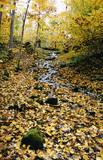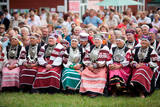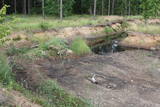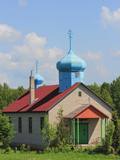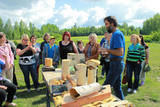| Nr | Name | Beschreibung |
|---|---|---|
|
Karņicka kalns pēc savas izcelsmes nav kalns, bet gan Daugavas ielejas nogāzes daļa ar labu skatu uz Krāslavas mazstāvu koka apbūvi. Ar šo vietu saistīts traģisks nostāsts par poļu virsnieka Josifa Karņicka un grāfa Plātera meitas mīlestību, kurai nebija lemts piepildīties tā laika „paražu” dēļ. Tā rezultātā abi nelaimīgie nolemj izdarīt pašnāvību. Virsnieks nošaujas, bet Emīliju pēdējā brīdī izglābj kalpone, neļaujot tai izlēkt pa pils logu. J. Karņicka pašnāvības vietā ir uzstādīts piemineklis. Nedaudz tālāk – rietumu virzienā guļ t.s. Austriņa akmens, pie kura 1909. gadā iedvesmojies un radījis latviešu rakstnieks Antons Austriņš. |
||
|
Errichtet an der Stelle, an der im Ersten Weltkrieg 1916 die sogenannte Weihnachtsschlacht der russischen gegen die deutschen Truppen stattfand. Nach dieser Schlacht wurde der Mut und die Heldenhaftigkeit der lettischen Schützen weit über die Landesgrenzen hinaus bekannt . Auf dem Ložmetējkalns (Maschinengewehrberg) ist eine Gedenkstätte für die lettischen Schützen errichtet und ein Aussischtsturm erneuert worden. Von dort aus sieht man das Maztīreļa purvs (Kleinheide Moor), die Stelle, an der ehemals eine deutsche Schmalspurbahn in Nord-Süd Richtung kreuzte, ist noch gut zu erkennen. Hier kann man sich auf eine Wanderung mit oder ohne Führer begeben, das Mangalis-Haus des Weihnachtsschlachtmuseums besuchen, in dessen Nachbarschaft eine Erkundungsroute errichtet ist, oder an thematischen Bildungsveranstaltungen und Schlachtimitationen teilnehmen. Zu besichtigen sind Denkmäler, Soldatengräber, Ausgrabungen, Fortifikationen, Erdhütten und mehr. Es gibt auch einen an autentischer Stelle rekonstruierten Abschnitt eines Befestigungssystems – einen Schutzbau und einen Teil der ersten deutschen Schutzlinie, den sogenannten „deutschen Wall“. |
||
|
Zemnieku saimniecībā "Rudzīši" iespējams apskatīt dažādus mājputnus - vistas, tītarus, dažādu šķirņu pīles un zosis. Mini zoo mīt arī cūkas, aitas un kazas. Tiek piedāvāta izjāde ar poniju, kā arī iespēja pārnakšņot brīvdienu mājā. |
||
|
A bit less than one kilometre from the Aizkraukle castle hill, the church can be seen from the Rīga-Daugavpils highway (A6). The church was built in 1688 on the steep banks of the
|
||
|
Saimniecība nodarbojas ar zirgkopību un aitkopību. |
||
|
Zirgi un citi lauku iemītnieki. Dažāda veida izklaides ar zirgiem gan saimniecībā, gan ārpus tās, un saimniecībā mitošo iemītnieku apskate. |
||
|
Pilsrundālē pa ceļam uz Rundāles pili var apmeklēt Retro auto kolekciju, kur apskatāmi 1939. g. automobiļi un dažādu laiku motocikli. Starp automobiļiem ir arī pasaulē šodien reti sastopami modeļi. Šī ir īstā vieta vēsturisko spēkratu cienītājiem! |
||
|
Lullemē atrodas blakus parka robežai, bet arī šo vietu ir vērts pieminēt kā vienu no apskates objektiem. Lullemē uzmanību piesaista viena otrai blakus stāvošās baznīcas. Mūsdienās redzamās 15. gs. celtās Sv. Marijas baznīcas drupas ir liecinieks 2. pasaules kara notikumiem, kad 1944. g. baznīcu sagrāva. Jaunā baznīca ir celta 1997. gadā. Ciema rietumdaļā uzstādīts piemineklis, kas veltīts brīvības cīņās (1919. – 1920.) kritušajiem. |
||
|
Die Kalkschlucht, die enstand, als sich der Baltische Eissee zurückzog wird von einem mächtigen Strom durchzogen – dem Mežmuiža. Sein Wasser enthält eine hohe Konzentration an Kalkstein. Das Wasser des Flusses fliesst in einen Mühlteich, der eine sehr interessante Farbe hat. Der Bildhauer Teodors Zaļkalns hat hier einst in der Kalksintermühle gelebt, die neben dem Teich steht. Waldpfade wurden für Besucher des Stromes eingerichtet.
|
||
|
Diese Kantine befindet sich auf der Hauptstraße von Livani und bietet hausgemachte und lettische Gerichte an. Lettische Küche: Kartoffelpfannkuchen, kalte Suppe, Graupen- und Gerstengrütze, Schweinerippen mit Sauerkraut, Brotsuppe. Das besondere Gericht: Steine der Flüsse Dubna und Daugava: Kartoffelklöße mit Quarkfüllung in Sauerrahmsoße. |
||
|
Die südöstlichste Ecke Estlands ist ein Gebiet mit einzigartiger kultureller Nuance, hier lebt eine interessante ethnische Minderheit – die Setus. Infolge der historischen Lage an der Grenze ist die Seto-Kultur eine Mischung von östlichen und westlichen Kultur – die Einflüsse kann man in ihrer Sprache, im Lebensstil, in der Küche und bei der Volkstracht erkennen. Besonders einzigartig ist die Gesangstradition der Setos - bezeichnet als Leelo, die zur UNESCO-Liste der Meisterwerke des mündlichen und immateriellen Erbes gehört. Zum Kennenlernen von Setomaa eignet sich am besten die touristische Route „Seto Külävüü“ (Seto Dorfgürtel). Die Route beginnt in Võõpsu und endet in Luhamaa und passiert mehrere Dörfer. Traditionelle Seto Küche gibt es in Tsäimaja im Seto Bauernmuseum (+372 505 4673, www.setomuuseum.ee) und in Taarka Tarõ im Seto Gemeindehaus in Obinitsa (+372 5620 3374, http://taarkatare.com ). Für Gruppen Verpflegung auf Vorbestellung, beim Wunsch werden Auftritte der lokalen Chöre und Führungen angeboten. |
||
|
Dundagas pili ieskauj parks, kura pirmsākumi ir meklējami jau 17. gs. Tam cauri tek Pāces upīte, kuras uzdambējums veido Dundagas dīķi. Tajā atrodas senatnē (vēl pirms pils būvniecības) mākslīgi veidota sala - Kalnadārza pilskalns. Tam iepretim (dīķa austrumu krastā) atrodas Dundagas pilskalns. Parkā joprojām zaļo (daži lielākie zari ir nolūzuši) t.s. “Rubļa ozols”, kura attēls bija uz 1919. g. izdotās Latvijas simts rubļu naudaszīmes. Parkā uzcelta estrāde. |
||
|
Malta (Borovaja, Borovska) Old-Believers Prayer House. The construction
of the church was started in 1931 by A. Gruncevičs. The Church is an architectural
monument of local importance.
|
||
|
Befindet sich in Alūksnē, Pils Straße 25 a. In einem am Anfang des 20. Jahrhunderts errichteten Gebäude des Handelspavillons wurde 1990 das Bibelmuseum von Ernst Glück errichtet, das die einzige Einrichtung dieser Art in Lettland und Baltikum ist. Das Museum ist dem Pfarrer und Aufklärer Ernst Glück (1652 – 1705) – dem ersten Bibelübersetzer ins Lettische gewidmet. Im Museum kann man sich mit den verschiedenen Bibelausgaben von 1694 bis heutzutage auf 38 Weltsprachen, den Ausgaben der Predigten und anderer christlicher Literatur bekannt machen. |
||
|
Nature restricted area has been established in old and overgrowing gravel pit and where rare species in Latvia - Natterjack toad (Bufo calamita) can be found. Natterjack toad needs open sand – gravel area therefore the population of it is decreasing once gravel pit is overgrowing by bushes. The population of this amphibian is depending on the activity of people in the area. There is very little chance to find Natterjack toad just by entering the restricted area, therefore please respect this area as especially sensitive.
|
||
|
Vainova Old-Believers Prayer House was built in 1980 replacing the previous
church that was burnt by lightening. Initially, the Prayer House was one of the
biggest churches in Latgale (for 2 000 people). The congregation of the church
exists since the 18th century.
|
||
|
Iepazīstina ar Somā nacionālā parka lielākā purva – Kureso (Kuresoo) ziemeļaustrumu daļu, kur redzamas purva ezeriņu un lāmu ainavas. Takas sākumā atrodas igauņu komponista, ērģelnieka un folkloras vācēja Marta Sāra (Mart Saar) (1882. – 1963.) dzimtās mājas. To apkaimē pļavas apsaimnieko aitas. Lokveida takas garums ir 4,2 km. |
||
|
Tāšu meistars Jurijs Ivanovs ar lielu centību un degsmi pēc seniem paraugiem cenšas atjaunot labākās Zilupes novada tāšu apstrādes tradīcijas. Top novadam raksturīgi autentiski tāšu trauki ķiploku, putraimu, saldumu, sāls uzglabāšanai, paliktnīši kafijas krūzei vai pannai. Īsts meistarstiķis ir darbarīku rokturu izgatavošana. Darbnīcā varēsiet izgatavot tāšu glezniņu, tāšu tauri, uzrakstīt īpašu vēstuli kādam ļoti mīļam cilvēkam. |
||
|
Atrodas austrumos no Alūksnes Tempļa kalna un dienvidos no Lieliem kapiem – Tempļa kalna parkā. Skatu torņa platforma atrodas apmēram 30 m augstumā virs Alūksnes ezera ūdeņiem. Labi redzama Marijas sala, Alūksnes parks, Alūksnes ezera piekraste līdz Kolberģim un Lāzberģim. Izcili ainavisks skats! |
||
|
This is a farm which produces beef. You can take a tour, during which you can learn about, taste and purchase untraditional herbs and exotic tea plants. |
||







